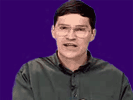
American Government compatible with AP*
Watch a sample video | Learn more | Table of contents | About the authorAccess to a complete online package that includes everything you need.
- Dynamic videos explain all of the topics and concepts to make you successful.
- Interactive exercises with immediate feedback allow you to track your progress.
- Illustrated notes help you review what you've learned in the videos.
- Subscriptions start when you are ready. Buy now and activate your course anytime you like. Wait up to one year to activate your subscription; your 12-month subscription doesn't begin until you say so!
There is no easier way to learn!
This optional CD-ROM set delivers the exact same video lectures delivered online, but without an internet connection. Online Subscription is required; CDs not sold separately. The CDs only contain the videos.
American Government compatible with AP* Details
Thinkwell's American Government Compatible with AP* American Government lays the foundation for success because, unlike a traditional textbook, students actually like using it. Thinkwell works with the learning styles of students who have found that traditional textbooks are not effective. Watch one Thinkwell video lecture and you'll understand why Thinkwell works better.
Comprehensive Video Tutorials
We've built American Government Compatible with AP American Government around more than 250 multimedia tutorials that provide dozens of hours of instructional material. Thinkwell offers a more engaging, more effective way for you to learn.
Instead of reading dense chunks of text from a printed book, you can watch video lectures filled with illustrations, examples, and even humor. Students report learning more easily with Thinkwell than with traditional textbooks.
Interactive Exercises with Feedback
There are hundreds of exercise items with explanations. Each video topic has corresponding exercises to test your understanding.
Test your understanding with hundreds of exercises that are automatically graded. Your results are available immediately, including explanations for each exercise. You can work on the exercises at the computer or print them out to work on later. Access your cumulative results anytime.
Review Notes and More
While the video lectures are the heart of Thinkwell products, we also offer concise, illustrated review notes, a glossary, transcripts of the video lectures, and links to relevant websites. All of these materials may be viewed online, and the notes and transcripts may be printed and kept for reference.
Table of Contents
(Expand All - Close All)1. Constitutional Principles
- 1.1 The Foundations of Government
- 1.1.1 An Introduction to Government
- 1.1.2 Why Government?
- 1.1.3 Who Governs?
- 1.1.4 Political Power
- 1.2 Political Culture
- 1.2.1 An Introduction to Political Culture
- 1.2.2 The Foundations of American Culture
- 1.2.3 Unity and Diversity
- 1.2.4 Video Biography: What Is Government?
- 1.3 The History of the Constitution
- 1.3.1 Britain and the Colonies
- 1.3.2 The Articles of Confederation
- 1.3.3 The Constitutional Convention
- 1.3.4 Final Steps to a Federal Government
- 1.3.5 The Road to Ratification
- 1.4 The Constitution in Action
- 1.4.1 The Bill of Rights
- 1.4.2 Checks and Balances
- 1.4.3 Amending the Constitution
- 1.5 Why Federalism?
- 1.5.1 Three Democratic Systems of Government
- 1.5.2 The Pros and Cons of Federalism
- 1.6 Federalism in Action: Divided Powers
- 1.6.1 Federalism Today
- 1.6.2 Federalism Through History
- 1.6.3 Hot Topic: The Federal Trump Card: The Commerce Clause
2. Civil Liberties and Civil Rights
- 2.1 An Introduction to Civil Liberties and Rights
- 2.1.1 The Creation of Rights
- 2.1.2 Equality of Opportunity Versus Equality of Results
- 2.1.3 Equal Protection Under the Law
- 2.2 First Amendment Rights
- 2.2.1 Freedom of Religion
- 2.2.2 Freedom of Expression: Criticizing the Government
- 2.2.3 Freedom of Expression: Pornography and Cyberspeech
- 2.2.4 Hot Topic: Hate Speech: Right to Free Expression or Invitation to Violence?
- 2.2.5 Freedom of Expression: A Free Press
- 2.2.6 The Right to Assemble
- 2.3 The Individual and Rights
- 2.3.1 Individual Freedoms Versus the Common Good
- 2.3.2 The Right to Privacy
- 2.3.3 Hot Topic: Email Privacy
- 2.3.4 The Individual in the Criminal Justice System
- 2.3.5 The Rights of the Accused
- 2.4 Additional Guarantees Under the Bill of Rights
- 2.4.1 Second Amendment: The Right to Bear Arms
- 2.4.2 Hot Topic: The Second Amendment and the Roberts Court
- 2.5 The African-American Struggle for Rights
- 2.5.1 Slavery and the Civil Rights Movement
- 2.5.2 The Struggle for Civil Rights: 1900–1950s
- 2.5.3 Civil Rights Legislation: 1960s and Later
- 2.5.4 Case Study: Brown v. Board of Education of Topeka
- 2.6 Civil Rights and Other Groups
- 2.6.1 Women and the Struggle for Rights
- 2.6.2 Rights Revolution: The Expansion of Rights
- 2.6.3 Hot Topic: Sexual Harassment
3. People and Politics
- 3.1 Public Opinion
- 3.1.1 What Is Public Opinion?
- 3.1.2 Political Socialization: Opinion and the Individual
- 3.1.3 Looking at Opinion Polls
- 3.2 Participation and Social Capital
- 3.2.1 Translating Opinion into Action
- 3.2.2 Who Participates?
- 3.2.3 The Importance of Participation: Social Capital
- 3.3 Mobilizing for Action
- 3.3.1 Organizing to Participate
- 3.3.2 Social Movements
- 3.3.3 Case Study: Same-Sex Marriages
- 3.3.4 Case Study: Same-Sex Marriage, Recent Developments
- 3.4 Interest Groups and Political Action Committees
- 3.4.1 Interest Groups and Their Impact on Politics
- 3.4.2 PAC Power
- 3.4.3 The Art of Lobbying
- 3.4.4 Regulating Organized Groups
4. Choosing Representatives
- 4.1 Political Parties: History and Origins
- 4.1.1 Political Parties and Their Functions
- 4.1.2 The American Two-Party System
- 4.1.3 A History of Political Parties in the U.S.
- 4.1.4 Case Study: Why No Socialism in America?
- 4.2 Political Parties Today
- 4.2.1 The Model of Responsible Party Government
- 4.2.2 Party Structure
- 4.2.3 Nominating
- 4.2.4 Parties and Money
- 4.2.5 The Changing Role of the National Convention
- 4.2.6 Hot Topic: Reform Party: New Party or Personal Vehicle?
- 4.3 Election Campaigns
- 4.3.1 Organizing to Run for Election
- 4.3.2 Campaign Strategy in the Primaries
- 4.3.3 Campaign Strategy in the General Election
- 4.3.4 Campaign Techniques, Part I
- 4.3.5 Campaign Techniques, Part II
- 4.3.6 Campaign Finance
- 4.3.7 Hot Topic: Campaign Finance Reform
- 4.3.8 Hot Topic: Update on Campaign Finance
- 4.4 Elections and Voting
- 4.4.1 Voter Turnout
- 4.4.2 Case Study: The Election of 1800: The Bitter Battle
- 4.4.3 Case Study: The Disputed Election of 1876
- 4.4.4 The Issues
- 4.4.5 Voting Decisions
- 4.4.6 Nonvoting
- 4.5 The Media and Politics
- 4.5.1 Media Influence on Elections
- 4.5.2 Media Bias
- 4.5.3 Influencing Elections and Shaping Public Opinion
- 4.5.4 Video Biography: Negative Campaign Ads
5. Political Institutions
- 5.1 Congress: Our Representatives
- 5.1.1 A Bicameral Legislative Body
- 5.1.2 Getting Elected to Congress
- 5.1.3 Staffs, Perks, and Specialized Offices
- 5.1.4 Roles of Legislators
- 5.1.5 Hot Topic: Term Limits
- 5.2 Congress in Action
- 5.2.1 Characteristics of the Two Houses
- 5.2.2 The House
- 5.2.3 The Senate
- 5.2.4 How a Bill Becomes Law
- 5.2.5 Evaluating Congress
- 5.3 The Office of the President
- 5.3.1 Being President
- 5.3.2 Presidential Leadership
- 5.3.3 The Presidential Staff and Advisers
- 5.3.4 Hot Topic: Presidential Pardons
- 5.4 The Roles of the President
- 5.4.1 Legislative Agenda Setter
- 5.4.2 National CEO
- 5.4.3 A World Leader
- 5.4.4 Hot Topic: Edith Wilson as Petticoat President
- 5.4.5 Party Leader
- 5.4.6 Hot Topic: Presidential Character
- 5.5 The Powers of the President
- 5.5.1 Powers and Privileges
- 5.5.2 Checks and Restraints on Presidential Power
- 5.5.3 Hot Topic: Executive Privilege
- 5.5.4 Hot Topic: Presidential War Powers
- 5.6 Divided Government
- 5.6.1 Controlling Extremes
- 5.6.2 Lobbying the President and Congress
- 5.6.3 Hot Topic: The Electoral College
- 5.7 The Federal Bureaucracy
- 5.7.1 The Federal Bureaucracy
- 5.7.2 Hot Topic: The Department of Homeland Security
- 5.7.3 Policymakers and Implementers
- 5.7.4 Budgetmaking
- 5.7.5 Controls on Bureaucracy
- 5.7.6 Reform Efforts
- 5.7.7 Case Study: The IRS
- 5.8 The Federal Court System
- 5.8.1 Court Powers and Restraints
- 5.8.2 Prosecution and Defense in Federal Courts
- 5.8.3 Case Study: Roe v. Wade and the Abortion Movement, Part I
- 5.8.4 Case Study: Roe v. Wade and the Abortion Movement, Part II
- 5.9 The Supreme Court
- 5.9.1 Appointing the Court
- 5.9.2 Leadership on the Supreme Court
- 5.9.3 Process and Calendar
- 5.9.4 Early Decisions That Defined Federal Power
- 5.9.5 Case Study: Affirmative Action
- 5.9.6 Case Study: Incorporation
- 5.9.7 Hot Topic: The Bush Appointments, 2001–2006
- 5.9.8 Hot Topic: The Obama Appointments
6. Public Policy
- 6.1 Policymaking
- 6.1.1 Purpose and Policymaking
- 6.1.2 Policy Development
- 6.1.3 Changing Public Policy
- 6.1.4 The Media and Governance
- 6.1.5 Case Study: School Vouchers
- 6.2 Economic Policy
- 6.2.1 Theories of Economic Policy
- 6.2.2 Tax Policy
- 6.2.3 How the Budget Influences Policy
- 6.2.4 Understanding Debts, Deficits, and Surpluses
- 6.2.5 Case Study: U.S. Debts, Deficits, and Surpluses
- 6.2.6 Managing the Economy
- 6.2.7 Case Study: The Credit Crisis of 2008
- 6.2.8 The Global Economy and the U.S.
- 6.2.9 Case Study: Energy Policy
- 6.2.10 Case Study: Environmental Policy
- 6.3 Social Policy
- 6.3.1 Promoting the General Welfare
- 6.3.2 Social Policy and Poverty
- 6.3.3 Senior Citizens
- 6.3.4 Health Care
- 6.3.5 Hot Topic: Health-Care Reform
- 6.3.6 Education
- 6.3.7 Hot Topic: Invisible Welfare
- 6.4 Foreign Policy: An Introduction
- 6.4.1 U.S. Foreign Policy: Pre–20th Century
- 6.4.2 U.S. Foreign Policy: 20th Century and Beyond
- 6.5 Foreign Policy: The Cast of Characters
- 6.5.1 The U.S. President
- 6.5.2 Influences on Presidents' Behavior
- 6.5.3 The United Nations
- 6.5.4 Treaties and Alliances
- 6.6 The Post-Cold War Era
- 6.6.1 Consequences of the Collapse of the USSR
- 6.6.2 Defense Issues
- 6.6.3 Foreign Aid
- 6.6.4 Hot Topic: The World Trade Organization: Corporate Power Run Rampant?
- 6.6.5 Hot Topic: 9/11 and the War on Terror
- 6.6.6 Hot Topic: The Iraq War
7. Toward a Changing Democracy
- 7.1 Citizen Participation in the New Century
- 7.1.1 A Clash of Values for Governance
- 7.1.2 Immigration and the New Governance
- 7.1.3 Political Participation in the New Century
- 7.1.4 Case Study: The 2000 Election
- 7.1.5 Case Study: The 2004 Election
- 7.1.6 Case Study: The 2006 Election
- 7.1.7 Case Study: The 2000 Census
8. Appendix: Key Supreme Court Cases
- 8.1 Key Supreme Court Cases
- 8.1.1 McCulloch v. Maryland
- 8.1.2 Miranda v. Arizona
- 8.1.3 Korematsu v. United States
- 8.1.4 Marbury v. Madison
- 8.1.5 New York Times v. Sullivan
- 8.1.6 City of Indianapolis v. Edmond
- 8.1.7 Santa Fe Independent School District v. Doe
- 8.1.8 Washington v. Glucksberg


